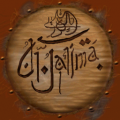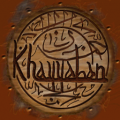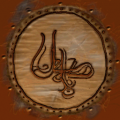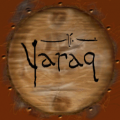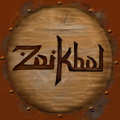Gharu'ndim Lore
Desert-dwellers who prefer knowledge and trade to war and bloodshed, the Gharu'ndim are an eminently honorable, formal culture, but they also have a reputation for being somewhat distant and proud. Of all the peoples of Dereth, they are the most drawn to the mysteries of magic.
Preferring to talk before fighting whenever possible, they speak with great politeness and formality, peppering their speech with honorifics and references to their national hero, the poet Yasif ibn Salayyar. - Gharu'ndim Description (Character Creation)
The Gharu'ndim are one of the Isparian Cultures. Their homeland is the kingdom of Gharu'n, on Ispar. Gharu'ndim are among the human heritage groups to find themselves displaced on Dereth, along with the Aluvians, Sho, and Viamontians. Gharu'ndim were the second of the human heritage groups to begin to arrive on Dereth.[1]
History on Ispar
The earliest mention of the Gharu'ndim people is in 771 RC, during the reign of Alfrega in Aluvia.[2][3][4] During this time, Alfrega was said to be wearing winterblue silks from the Garondish lands[2] (The Gharu'ndim are sometimes called Garondish by outsiders).[5] While this may not seem significant, it shows that the Ghuru'ndim were seen as a distinct people that had contact with other cultures, approximately 150 years prior to the official founding of the nation of Gharu'n.[6]
Founding of the Nation
Leading up to the founding of Gharu'n, the text The Hundred Trackless Paths by Khaymahlai described the Gharu'ndim people as having lived and currently living in the Naqut Desert.[7] It is in this text that we first hear of Rakhil al-Khur. In volume 7 of The Hundred Trackless Paths, Rakhil was said to be traveling north by boat along a river, when he stopped at a village on the southern edge of the Naqut. After defeating the demon Hayyaz, who had claimed ownership of the village, Rakhil asked the villagers to follow him north to Roulea.[7]
Prior to 924 RC, the nomadic Gharu'ndim people, led by Malik Rakhil al-Khur and the warrior-poet Yasif ibn Salayyar, headed north, across the Naqut, on a campaign to conquer Roulean lands.[1][8][6] During this campaign, one of the five Crimson Stars, Al-Ghul, was renamed Al-Khur in honor of Rakhil al-Khur, after the great victory won at the salt mines to the east of Tirethas.[9]
In 924, the Gharu'ndim armies seiged the Roulean capital of Tirethas, the City of Lore.[1][6] As his armies prepared to destroy the city, Rakhil threatened to burn the books inside her walls. Yasif, who could not bear the thought of destroying the ancient city's works and lore, struck down his Malik.[1][6] Rather than executing him, the armies agreed to honor Yasif and the conquest of Roulea ended.[6] In all, half of Roulea's lands were lost to the new nation of Gharu'n. Rakhil al-Khur's son, Amul ibn Rakhil became the new Malik and Yasif became his adviser.[1]
Kidnapping of the Poet
After the founding of Gharu'n many of the other realms about the Ironsea had not recognized their sovereignty, so Yasif traveled to the other nations, including Aluvia, Viamont, Roulea, and Silvera, to win the respect of neighboring rulers - All except Milantos, who refused Yasif's petitions to travel to their nation and hold parley with Arpad, their king. Eventually, king Arpad of Milantos died. Without a son or any living male relatives, his advisor Laszko became king. Yasif sent another request to the new king, and to to his surprise, Laszko agreed. Yasif traveled to the port of Mawwuz and sailed to Milantos.[10]
Yasif was only supposed to be gone for four months. Six months passed, and worry began to grow in Gharu'n. After seven months, soldiers began to gather at the Malik's palace, readying for an invasion of Milantos. Malik Amul received a letter from King Laszko, threatening to kill Yasif if Gharu'n invades. The letter contained the severed finger of the poet. Amul disbanded the army.[10]
Yasif had been gone for two years. Malik Amul had sent missives to Milantos demanding King Laszko for the return of his emissary, asking what Laszko wishes as ransom, and pleading for a reason why Yasif has been taken, all without response. Finally, a second letter was sent from Milantos. It was blank, and contained a second finger of Yasif. Soon after, young men and women from the al-Nafalt began to disappear. Mansur al-Rajan was among them. Mansur was taken to a hidden mountain fortress, where he and 49 others were held for 30 days. Malik Amul arrived and addressed them on why they had been taken. Thus marked the formation of the secret organization known as the Shagar Zharala, the Walkers in Shade. The 50 trained for three years in the mountain fortress. At the end, 36 of the 50 became the first Zharalim. Twelve of the best Zharalim returned with the Malik to the al-Nafalt.[10]
One week before the Zharalim were to be sent out to rescue the poet, Yasif returned to the palace. He had been freed by his jailer. During his imprisonment in Milantos, Laszko had used Yasif for dark rituals, and Yasif had lost his eyes along with all digits on his left hand. Yasif requested that Mansur remain at the al-Nafalt as his guide. The other eleven Zharalim were sent to Milantos. They killed Laszko, but all eleven perished before they could return to Gharu'n.[10]
Yasif lived out his days in the al-Nafalt, the Palace of One Hundred Gardens. It is during this time that he composed his greatest work, the Alamakhaida. This poem, over 1,000 lines long, codified the Gharu'ndim system of honor. When Yasif died, the people of Gharu'n mourned his death for a full year.[1]
Century of Storms
Soon after the death of Yasif, Amul ibn Rakhil also died, poisoned at his own birthday celebration. Amul died without an heir, and the nation of Gharu'n fell into chaos. For the next 100 years, no fewer than 25 Maliks ruled the land. This period of time is known as the Century of Storms.[1]
Due to the chaos of this time, it is not clear who succeeded Amul ibn Rakhil. It is known that Mansur al-Rajan, the former guide to Yasif, served as the vizier to Malik Tu'azar ibn Amul.[10] Although Tu'azar's name implies that he was the son of Amul ibn Rakhil, it is known that Amul died heirless.[1]
In 1018 RC, after some 15 years of chaos in Gharu'n, Ladriya bint Daum decided to leave Tirethas and return to her home in Taban. Halfway through her journey, Ladriya's caravan was attacked at night by band of nomads sent by the renegade Shayk Ridqidh. Ladriya was wounded badly but was saved by Tamsah ibn Jaidah, who carried her away on his stallion.[9]
After riding for six days, Tamsah and Ladriya arrived at the oasis of Shiryaz. They stayed there for almost two months while Ladriya recovered. On 6th of Solclaim, 1018 RC, Tamsah and Ladriya returned to the court of Taban at Nishadina. Ladriya ordered the forging of the Silifi of Crimson Stars, to be wielded by Tamsah. Ladriya went on to be become Malika, although her reign was likely short, as her life is described as brief but brilliant.[9]
During the Century of Storms, The al-Nafalt was razed. Near the end of the Century of Storms, the kingdom of Viamont sent armies to Gharu'n to invade.[1][11] The Viamontians installed Zahir ibn Ma'mun as a puppet leader, while they ruled Gharu'n from afar.[1]
During his rule, Zahir ibn Ma'mun murdered all his rivals, except for a young lord named Jawhar al-Shamshir. Seeing what had become of his homeland, Jawhar traveled the desert in secret, banding together the people. Jawhar defeated Zahir ibn Ma'mun and drove the Viamontians from the shores of Gharu'n. He became the new Malik, and returned Gharu'n to the glory it had known in Yasif's time.[1]
Recent Past
Many years after the end of the Century of Storms, when Gharu'n was a peaceful land and the smiths forged many more plowshares than swords, Taraj al-Saum was the reigning Malik.[12]
It was during this time that the minor noble Mu'allim Fasair ibn Jambuz sent out a call across the land for warriors. More than 250 warriors answered the call, among them Ibriya bint Raglan. In this time the sight of women wearing armor and bearing swords was still strange, and Ibriya was was the only woman among all the warriors.[12]
Fasair announced the reason the warriors had been gathered: Ulyush al-Nadur, one of the most renowned fighters in the kingdom, had died barely a month ago. Ulyush was to marry Fasair's daughter, Lashanda. The wedding was to be in three days, and the Mu'allim was determined to continue with the ceremony. Over the next three days, the warriors competed in a tournament to win Lashanda's hand.[12]
In the end, Ibriya defeated all the other contestants and won the tourney. But she did not desire to wed the Mu'allim's daughter - instead, she gave her prize to Lashanda, giving her the right to choose her husband.[12]
Present Day
In 1274 RC, the Malika Qadira bint Balj reigned in Gharu'n. In this time, there was always the threat of war, from both Viamont and Milantos, but the desert kingdom was once again a place where the sharpness of a man's mind is far more valuable than that of his sword.[1]
Later in 1274 RC, Portals began to appear in Aluvia. The appearance of these portals disrupted all of Ispar. No one knew what they were or why they had appeared. The people of Ispar were afraid, and the Viamontians took advantage of this situation.[13]
Still later in 1274 RC, Viamont invaded Aluvia and Roulea. After early victories in Aluvia, the Aluvians put up a resistance, and the war fell into a stalemate. The Duke Bellenesse led the invasion of Roulea. The Roulean Empire collapsed, its imperial army annihilated and its Emperor killed in his palace by Bellenesse. The Viamontian army pressed on to Gharu'n.[11]
Within two years, after a siege by sea and by land, the Viamontians took Tirethas. Viamontian army marched east along the northern edge of the Naqut, pushing back the Gharu'ndim army. Gharu'ndim resistance solidified around the city of Shiryaz. Viamontians were fought to a standstill there, and Shiryaz remained free.[11]
Some years later, Talal ibn Qamuz of Nishadina was caught smuggling Old Roulean texts, saved from Tirethas, to sell to the Viamontians. The Malika of Gharu'n used this situation to her advantage, and ordered Talal to Viamont, with 1000 copies of the the Roulean text The Treatise of the Individual. He was sent to Viamont to peddle these copies to his Viamontian clients of nobility, including Countess Lotila, Count Renari, and Duke Bellenesse. As punishment for his crime, he was forever banished from Gharu'n.[14]
In 1284 RC, portals began to appear in Gharu'n.[6] In 1286 RC, the Viamontian army camped outside Shiryaz was recalled back to Viamont, to deal with a crisis in their homeland.[11]
In 1295 RC, the last remnants of Bellenesse's rebellion had been all but eradicated. The followers of Bellenesse had distracted King Varicci from his campaigns elsewhere on Ispar, but with the rebellion defeated, Varicci once again turned his attention to the other lands of Ispar.[15] The war between Aluvia and Viamont continued. Aluvia held their western borders, and both sides had taken heavy losses, but the tides seemed to be turning in favor of Viamont.[16] The war between Gharu'n and Viamont continued as well. The Gharu'ndim believe their nation only continues to exist because King Varicci had not yet chosen to press his attack.[17] The Sho worried what will happen to them should the Viamontians conquer Gharu'n completely.[18]
Timeline
The following information has been pieced together from numerous sources. For more information, see Continuity - Gharu'ndim History.
| Portal Year | Roulean Year | Event |
|---|---|---|
| -606 to -577 PY | 880s to 890s RC |
Rakhil al-Khur and Yasif ibn Salayyar are most likely born during this time. |
| -554 to -546 PY | 915 to 920 RC |
During this time, the Naqut Desert divides the Milantean lands from the decaying Roulean empire.[7] The Naqut is the home of the Gharu'ndim people.[7]
|
| -542 PY | 923 RC |
One of the five Crimson Stars, Al-Ghul, is renamed Al-Khur in honor of Rakhil al-Khur, after the great victory won at the salt mines to the east of Tirethas.[9] |
| -540 PY | 924 RC |
Gharu'n armies seige the Roulean capital of Tirethas, the City of Lore.[6]
|
| -538 PY | 925 RC |
Mansur al-Rajan is born. Mansur would later serve in the kitchen of the al-Nafalt during the reign Malik Amul ibn Rakhil, be a part of the first group of Zharalim, and become vizier to Malik Tu'azar ibn Amul.[10]
|
|
After the founding of Gharu'n many of the other realms about the Ironsea have not recognized their sovereignty, so Yasif travels to the other nations, including Aluvia, Viamont, Roulea, Silvera to win the respect of neighboring rulers - All except Milantos, who refuses again and again Yasif's petitions to travel to their nation and hold parley with Arpad, their king.[10] | ||
| -517 PY | 939 RC |
King Arpad of Milantos dies. Without a son or any living male relatives, his advisor Laszko becomes king. Yasif sends another request to the new king, and to to his surprise, Laszko agrees. Yasif travels to the port of Mawwuz and sails to Milantos.
|
| -514 PY | 941 RC |
Yasif has been gone for two years. Malik Amul has sent missives to Milantos demanding King Laszko for the return of his emissary, asking what Laszko wishes as ransom, and pleading for a reason why Yasif has been taken, all without response. Finally, a second letter is sent from Milantos. It is blank, and contains a second finger of Yasif.
|
| -510 PY | 944 RC |
The 50 train for three years in the mountain fortress. At the end, 36 of the 50 become the first Zharalim. Twelve of the best Zharalim return with the Malik to the al-Nafalt.
|
| -438 PY | 992 RC |
Ladriya bint Daum is born.[9] |
| -423 PY | 1002 RC | Gharu'n
Yasif ibn Salayyar dies. Gharu'n mourns for one full year.[1] |
| -422 PY | 1003 RC |
Soon after the death of Yasif ibn Salayyar, Amul ibn Rakhil also dies, heirless, poisoned at his own birthday celebration. Gharu’n falls into chaos.[1]
|
| -419 PY | 1005 RC |
The Gharu'ndim group known as Walim, The Searchers, appear a few years after the death of Yasif, vowing to continue his explorations of the nature of truth.[19] |
|
Tu'azar ibn Amul is the Malik. Mansur al-Rajan serves as his vizier.[10] | ||
| -399 PY | 1018 RC |
After some 15 years of chaos in Gharu'n, Ladriya bint Daum decides to leave Tirethas and return to her home in Taban.
|
| -393 PY | 1022 RC |
20 years after the death of Yasif ibn Salayyar, Mansur al-Rajan recounts his experiences which are recorded in the historical text The Nights of al-Nafalt.[10] |
|
Near the end of the Century of Storms, Viamont sends armies to Gharu'n to invade. The Viamontians install Zahir ibn Ma'mun as a puppet leader, while they rule Gharu'n from afar.[1] | ||
|
During his rule, Zahir ibn Ma'mun murdered all his rivals, except for a young lord named Jawhar al-Shamshir.
| ||
| -272 PY | 1103 RC |
Jawhar defeats Zahir ibn Ma'mun and drives the Viamontians from the shores of Gharu'n. He becomes the new Malik, and returns Gharu'n to the glory it had known in Yasif's time.[1]
|
| -15 PY | 1274 RC |
The Malika Qadira bint Balj reigns in Gharu'n. There is always the threat of war, from both Viamont and Milantos, but the desert kingdom is once again a place where the sharpness of a man's mind is far more valuable than that of his sword.[1] |
| -15 PY | 1274 RC |
The appearance of the portals in Aluvia has disrupted all of Ispar. No one knows what they are or why they have appeared. The people of Ispar are afraid, and the Viamontians take advantage of this situation.[13] |
| -15 PY | 1274 RC |
Viamont invades Aluvia and Roulea. After early victories in Aluvia, the Aluvians put up a resistance, and the war falls into a stalemate. The Duke Bellenesse leads the invasion of Roulea. The Roulean Empire collapses, its imperial army annihilated and its Emperor killed in his palace by Bellenesse. The Viamontian army presses on to Gharu'n.[11] |
| -12 PY | 1276 RC |
Within two years, after a siege by sea and by land, the Viamontians take Tirethas. Viamontian army marches east along the northern edge of the Naqut pushing back the Gharu'ndim army. Gharu'ndim resistance solidifies around the city of Shiryaz. Viamontians are fought to a standstill there, and Shiryaz remains free.[11] |
| -2 PY | 1283 RC |
Talal ibn Qamuz of Nishadina is caught smuggling Old Roulean texts, saved from Tirethas, to sell to the Viamontians. The Malika of Gharu'n uses this situation to her advantage, and orders Talal to Viamont, with 1000 copies of the the Roulean text The Treatise of the Individual. He is sent to Viamont to peddle these copies to his Viamontian clients of nobility, including Countess Lotila, Count Renari, and Duke Bellenesse. As punishment for his crime, he is forever banished from Gharu'n.[14] |
| 0 PY | 1284 RC |
Portals to Dereth begin to appear in Gharu'n and Sho.[6] |
| 3 PY | 1286 RC |
The Viamontian army camped outside Shiryaz is recalled back to Viamont, to deal with a crisis in their homeland.[11] |
| 16 PY | 1295 RC |
The last remnants of Bellenesse's rebellion have been all but eradicated. The followers of Bellenesse had distracted King Varicci from his campaigns elsewhere on Ispar, but with the rebellion defeated, Varicci once again turns his attention to the other lands of Ispar.[15]
|
History on Dereth
Some the first Gharu'ndim arrived on Dereth while visiting Aluvia. Two such people are Jenavere and her father. When she was younger, Jenavere had traveled with her father, a silk trader, to Aluvia. While there they encountered a portal to Dereth.[20] After Elysa Strathelar and Thorsten Cragstone liberated the hive that Jenavere and her father were in, Jenavere had an opportunity to share a meal with Elysa and Cragstone. During this meal, Elysa shared the story of the time she encountered Asheron.[20] This puts Jenavere's arrival in Dereth around -1 PY to 0 PY.[6]
The Gharu'ndim began to arrive en masse on Dereth in 0 PY, after the Aluvians had freed themselves from the Olthoi.[6][21] Soon after, the Sho began to arrive.[1][22] In the early days, the Gharu'ndim, Aluvian, and later Sho had some conflict between each other, but violence proved futile with the appearance of Lifestones.[23]
One of the first Gharu'ndim to arrive was Musansayn, a minor noble from Ispar. He became the effective leader of his people. He made peace with the Aluvians, and arranged for his people to settle the lands west of the Falamar Hills.[21] Another figure of note was Wari al Sha'im, a great warrior and friend of Musansayn from Ispar.[24] Wari was a great defender of his people, and helped found Samsur in the Yushad Ridge.[21][24] Samsur was the first permanent settlement of the Gharun'dim under Musansayn's rule.[21]
Some of the Gharu'ndim who first arrived on Dereth had been life-long desert dwellers on Ispar, and rejected the idea of living in the Yushad Ridge. Their leader was a wizard named Raqur al-Hayra, and he led his fellow desert dwellers across the A'mun Desert to a cove along the coast of the Inner Sea. In the cove they discovered an oasis. Raqur thrust his staff into the ground, bringing forth fresh water, and declared that all the desert folk would be welcome in this place. Raqur was later killed in a magic duel with a Mu-miyah archmage before the town, Yaraq, was completed.[25]
Far to the south, the isolated stronghold of Qalaba'r was constructed.[21][26] Zaikhal was also founded around this time, as an early map of the Gharu'ndim kingdom on Dereth shows only Samsur, Yaraq, Zaikhal, and Qalaba'r.[27]
Musansayn and Wari continued to expand the Gharu'ndim Kingdom.[24] To the north, the town Al-Jalima was founded during the Gharu'ndim's efforts to expand their realm.[28] The town of Uziz was settled after explorers trekking out south from Samsur discovered a calm, clear pool of fresh water, believed by some scholars to be a reservoir left behind by the Empyrean.[29] Some time prior to 5 PY, Musansayn was known to have said that his realm included Yaraq, Al-Jalima, and Uziz.[24]
At some point prior to 5 PY, Wari al Sha'im chose to leave the safety of Samsur and headed into the desert. He said that, while many had declared their realm to be at peace, it was a false peace, and many dangers still threatened their people just beyond the patrols of their towns. [24] At some point later, Musansayn also wandered into the desert and disappeared.[21][30] Shortly after he vanished, the scribes and historians of Zaikhal descended upon Musansayn's library and made off with much of his literary collection.[30][31] The Fountain of Musansayn was constructed in Samsur in 5 PY, after the leader had vanished.[21] Some say that he died in the desert, while others claim that he will return one day.[21][31]
After the discovery of fresh water south of Samsur and subsequent founding of Uziz, the Gharu'ndim wished to connect the isolated southern village of Qalaba'r to the rest of their realm. Soon a great road stretched the whole of the Yushad Ridge, from the capital of Zaikhal to Qalaba'r. The distance from Uziz to Qalaba'r, however, was quite long and still dangerous. Travelers lobbied at the capital for a way-point between the two settlements. And so, thanks to the support of the wealthy Aluvian noble Lord Balthall, the town of Khayyaban was founded.[32]
In 9 PY, Al-Arqas was settled when Gharu'ndim desert-walkers discovered a spring. By 10 PY the town was flourishing, as it provided a convenient halfway-point for travelers moving between Yaraq an southern towns like Uziz and Khayyaban.[33][34]
In Solclaim, 11 PY, the noble Jaleh al-Thani Led a caravan of like-minded Sho and Gharu'ndim across the Direlands and settled near the Darktide Festival Stone, establishing the town of Ayan Baqur.[6][35] In Thistledown, 11 PY, Tufa, a tent village surrounding a desert oasis,[21] was obliterated by Shadow Spire attacks.[36] The next month, in Harvestgain, 11 PY, the Gharu'ndim uncovered the ancient Yalaini grottos of Laeraa. Deep inside, Zaikhal Arcanum scholars discovered one of the Seaborne Empire's archives, filled with thousands of Empyrean tomes.[37]
Culture
The Gharu'ndim people are described as honorable, formal, distant, and proud.[1][38][39] They value knowledge and trade over war and bloodshed,[1][38][39] but are skilled fighters when necessary.[40] They speak with great politeness and formality, peppering their speech with honorifics and references to their national hero, the revered poet Yasif ibn Salayyar.[1][38][39][40] It is said that the Gharundim are descended from powerful magicians, gifted poets, and intrepid traders.[41] It is also said that of all the Isparian people called to Dereth, they are the most drawn to the mysteries of magic.[38]
Polytheistic Religion
The Gharu'ndim have an older polytheistic religion that includes both gods and demons. Among these gods is Sulmada, the god of dance.[9] Yujazik is the flaming mountain the court of the gods was built upon.[9] Mahwan is the citadel upon Yujazik.[9] Some of the demons include Al-Shajar the storm-demon,[9] Hayyaz, a demon made of steam,[7] and the Gria'venir, a race of spider demons.[42][43]
These gods and demons are often described as old or ancient. In the 930s (approximately 370 years ago), after Yasif had been kidnapped and young people began to disappear from the al-Nafalt, Mansur al-Rajan wrote that, "it was as if one of the old gods had stolen them, and indeed many of the servants believed just that." Later, when the disfigured Yasif had returned, the Malik Amul was said to have cursed, "ancient gods."[10] In 1018 RC, when Ladriya bint Daum was instructing how the five rubies she had named after the Crimson Stars were to be enchanted, she described Yujazik as the mountain where the court of the old gods was built. She described Sulmada as an old god, and Al-Shajar as a demon from the old stories.[9] And recently, when the Arcanum on Dereth were choosing a name for the spider-like Grievvers, they said that Gria'venir came from Gharu'ndim mythology.[42][43]
The fact that they call refer this as mythology and old stories, rather than history or religion, makes it seem as though the Gharu'ndim no longer believe in these deities. However, it appears there are some that still do. Both Zarri ibn Khaybi, the archmage of Xarabydun, and Hasina bint Rira, the wandering archmage, will bless patrons with the phrase, "may the gods stand between you and harm in all the empty places you must walk."[44][45]
Yasif ibn Salayyar
After returning from Milantos, Yasif ibn Salayyar was no longer fit to serve as Emissary, so he became the Poet.[9] He wrote many works, but his greatest of all was the Alamakhaida.[1][9] This poem, which is over a thousand lines long, codifies the Gharu'ndim system of honor. Philosophers have boiled it down to twelve fundamental precepts, called the Ghayaraqa Yadina, or Dozen Roads of honor.[1][9] The roads are as follows:[1]
- Love those who do you good.
- Welcome those you do not know.
- Honor the land, sky and sea.
- Take pleasure in that which is pure.
- Avoid that which is corrupt and sinful.
- Harm no innocent, for those who do so harm themselves.
- Place your lord's life above even your own, so long as he remains just.
- Let your vengeance be swift, and take no pleasure from it.
- Speak with respect, to friend and foe alike.
- Use your mind before your sword.
- Let your death have meaning.
- Seek friendship before wealth, for friendship lasts longer.
When Yasif died, the people of Gharu'n mourned his death for a full year. Now, approximately 300 years later, Yasif is regarded as a national hero.[1][38][39][40] Gharu'ndim are known to use honorifics and references to Yasif such as, "Thanks be to the Poet."[46][47] "The grace of the Poet be upon you,"[48] and, "The grace of the Poet upon you, friend."[49] Yasif's teachings included the belief in an afterlife. Hamud ibn Rafik wrote that "true paradise" is the reward that comes from a righteous existence and an honorable death.[50] Hamud also wrote that, because of his transformation into a Shadow, he will never reach the gardens of delight spoken of by ibn Salayyar.[51] At least some Gharu'ndim have given Yasif a spiritual role, as an unknown author once referred to him as, "our great prophet, ibn Salayyar."[52]
Other Religious Customs
At least one Gharu'ndim, Aaminah, believes that in order for a person's soul to find rest among their ancestors, any slights the deceased made against others must be settled.[53]
Customs and Traditions
In winter, the howling storm-winds called the Djinaya begin to gust across the Naqut Desert. The Djinaya bring with them a period the Gharun'dim call the Dusk, for the flying sand catches the light of the sun, and filters it into a dim and ruddy memory of itself. Only the boldest and most skilled mages venture out into the disorienting, blinding sandstorms. To aid travelers, the Gharun'dim erect oil lamps along their streets and near the gates of their towns. These burn with a bright, clear blue light that can be seen through the harshest weather. The Gharun'dim celebrate the Night Feast at this time, offering shelter and hospitality to any brave enough to go visiting. During the day, men and women shut in by the storms spend their time in prayer and reflection -- prayer for fortune in the coming year, and reflection on the failings and triumphs of the preceding one. As the poet says, wisdom can be found only in quiet places. Each evening, however, the entire populations of Gharun'dim towns dress in their finest garments and gather in the marketplace. Food and drink are shared, and the most accomplished storytellers stand before the assembled host, telling wild tales of magic, whimsy, and romance for the amusement of the feasters.
Those traveling in the Gharun'dim lands during the Dusk will be warmly welcomed in any home, and invited to share a cup of palm wine and a tale. For the Gharun'dim, Night Feast is a time for storytelling and contemplation. [54]
Governance
Like the other Isparian cultures, the Gharu'ndim have a feudal society.[55][56][57] Gharu'ndim allegiance ranks are as follows:
| Rank | Male Title | Female Title |
|---|---|---|
| 10 | Sultan | Sultana |
| 9 | Malik | Malika |
| 8 | Amir | Amira |
| 7 | Mushir | Mushira |
| 6 | Qadi | Qadiya |
| 5 | Naqib | Naqiba |
| 4 | Mu'allim | Mu'allima |
| 3 | Maulan | Maulana |
| 2 | Shayk | Shayka |
| 1 | Sayyid | Sayyida |
Despite their highest governmental title being Sultan, there are no records that any ruler of Gharu'n has ever held that title. Rakhil al-Khur, the founder of Gharu'n, held the title of Malik.[1][8] Rakhil's son and successor, Amul ibn Rakhil, also held the title of Malik.[1][10] This trend continued through the Century of Storms[1][9][10] and even into the present day with the Malika Qadira bint Balj.[1]
Other titles held by Gharu'ndim include Vizier [10][9] and Faris.[9]
Factions
- Jaladhaqa Qalathina, the Jaladh - The Warriors' Brotherhood
- Khuraqa Tha'ratali, the al-Khuraqa - Children of the Eagle
- Ighazaqa Talina, the al-Ighaz - Academy of Sorcery
- Walim - The Searchers
- al-Sadharamad - The Way of Stealth
- Shagar Zharala, the Zharalim - The Order of Assassins
Names
For more information, see Gharu'ndim Lore/Names.
Female
There are three ways Gharu'ndim women's names are formed:
- 'ism: A first name, with no surname. Examples: Jaidmala, Di'zarafa, Hajliya
- Hisba: A first name, plus 'al-' and a surname. Examples: Qaysbah al-Halras, Nuhnada al-Thudadh, Majqiya al-Ruz.
- Nasab: A first name, plus 'bint' (meaning 'daughter of') and a surname. Examples: Ashrifa bint Yazman, Shulima bint Bashr, Khayla'ida bint Tiqiq.
Male
There are three ways Gharu'ndim men's names are formed:
- 'ism: A first name, with no surname. Examples: Sunnuj, Tiqabar, Abham.
- Hisba: A first name, plus 'al-' and a surname. Examples: Ma'whar al-Qutuz, Uzik al-Zaraf, Fadlmar al-Tuwah.
- Nasab: A first name, plus 'ibn' (meaning 'son of') and a surname. Examples: Abdiris ibn Mauki, Tashtal ibn Yufa, Dharilal ibn Qa'yam.
Real World Basis
The following statements have been made about the real world basis of the Gharu'ndim:
- The Gharu’ndim culture is loosely based on those of the Moors of al-Andalus (southern Spain).[58]
- Gharu'ndim names are Middle Eastern in flavor.[40]
- Gharu'ndim are comparable to the ancient Middle Eastern people. [59]
Texts
![]() A letter to Devana
A letter to Devana![]() Animal Talker
Animal Talker![]() Derethian Skies
Derethian Skies![]() Devana's Note
Devana's Note![]() Dizah ibn Nadqab's Journal
Dizah ibn Nadqab's Journal![]() Dry Well Directions
Dry Well Directions![]() Dungeon Binar Directions
Dungeon Binar Directions![]() Hamud's Last Testament
Hamud's Last Testament![]() Excavation Directions
Excavation Directions![]() Excerpts from the Zharalim
Excerpts from the Zharalim![]() Lashanda's Hand
Lashanda's Hand![]() Letter From Home (Gharu'ndim)
Letter From Home (Gharu'ndim)![]() Midnight Revelation
Midnight Revelation![]() Musansayn's House Directions
Musansayn's House Directions![]() Precepts of the Tenebrous Edge
Precepts of the Tenebrous Edge![]() Recalling the Calling
Recalling the Calling![]() Story of Winthura's Gardens
Story of Winthura's Gardens![]() The Fallen Master of Shagar Zharala
The Fallen Master of Shagar Zharala![]() The Hundred Trackless Paths
The Hundred Trackless Paths![]() The Silifi of the Crimson Stars
The Silifi of the Crimson Stars![]() To Be A Shadow
To Be A Shadow![]() Zharalim Foreman's Journal
Zharalim Foreman's Journal![]() Zharalim Master's Journal
Zharalim Master's Journal
Town Network Signs
![]() Gharu'ndim (Town Network Sign)
Gharu'ndim (Town Network Sign)![]() Al-Arqas (Town Network Sign)
Al-Arqas (Town Network Sign)![]() Al-Jalima (Town Network Sign)
Al-Jalima (Town Network Sign)![]() Khayyaban (Town Network Sign)
Khayyaban (Town Network Sign)![]() Qalaba'r (Town Network Sign)
Qalaba'r (Town Network Sign)![]() Samsur (Town Network Sign)
Samsur (Town Network Sign)![]() Tufa (Town Network Sign)
Tufa (Town Network Sign)![]() Uziz (Town Network Sign)
Uziz (Town Network Sign)![]() Xarabydun (Town Network Sign)
Xarabydun (Town Network Sign)![]() Yaraq (Town Network Sign)
Yaraq (Town Network Sign)![]() Zaikhal (Town Network Sign)
Zaikhal (Town Network Sign)
Internet Articles
- Zogblaster Archive/Heritage Groups/Gharu'ndim
- Zogblaster Archive/Heritage Groups/Gharu'ndim/Gharu'ndim Factions
- Zogblaster Archive/Heritage Groups/Gharu'ndim/Lashanda's Hand
- Zogblaster Archive/Heritage Groups/Gharu'ndim/A Poet Vanishes (To Be a Shadow)
- AC:DM CD Lore - Gharu'ndim Heritage
- Character Creation - Racial Lore: Gharu'ndim
- Character Creation - Naming: Gharu'ndim
Printed Materials
Items
![]() Budiaq
Budiaq![]() Dabus
Dabus![]() Djarid
Djarid![]() Kaskara
Kaskara![]() Katar
Katar![]() Khanjar
Khanjar![]() Nabut
Nabut![]() Shamshir
Shamshir![]() Silifi
Silifi![]() Simi
Simi![]() Takuba
Takuba![]() Tungi
Tungi![]() Wand (Gharu'ndim)
Wand (Gharu'ndim)![]() Yag
Yag
![]() Baigha
Baigha![]() Scalemail Basinet
Scalemail Basinet![]() Scalemail Bracers
Scalemail Bracers![]() Scalemail Breastplate
Scalemail Breastplate![]() Scalemail Cuirass
Scalemail Cuirass![]() Scalemail Gauntlets
Scalemail Gauntlets![]() Scalemail Girth
Scalemail Girth![]() Scalemail Greaves
Scalemail Greaves![]() Scalemail Hauberk
Scalemail Hauberk![]() Scalemail Leggings
Scalemail Leggings![]() Scalemail Pauldrons
Scalemail Pauldrons![]() Scalemail Shirt
Scalemail Shirt![]() Scalemail Tassets
Scalemail Tassets
![]() Dho Vest and Robe
Dho Vest and Robe![]() Fez
Fez![]() Kiyafa Robe
Kiyafa Robe![]() Qafiya
Qafiya
![]() Shadow's Garb
Shadow's Garb![]() Veil of Darkness
Veil of Darkness![]() Shroud of Night
Shroud of Night![]() The Poet's Mask
The Poet's Mask![]() Mask of the Malik
Mask of the Malik
![]() Silifi of Crimson Stars
Silifi of Crimson Stars![]() Ibriya's Choice
Ibriya's Choice![]() Wings of Rakhil
Wings of Rakhil![]() Star of Gharu'n
Star of Gharu'n
![]() Pathwarden Scale Hauberk
Pathwarden Scale Hauberk![]() Pathwarden Scale Leggings
Pathwarden Scale Leggings
Art & Images
References
- ↑ 1.00 1.01 1.02 1.03 1.04 1.05 1.06 1.07 1.08 1.09 1.10 1.11 1.12 1.13 1.14 1.15 1.16 1.17 1.18 1.19 1.20 1.21 1.22 1.23 1.24 1.25 1.26 1.27 1.28 1.29 1.30 1.31 1.32 1.33 1996-1999 (unknown) Asheron's Call Beta - Zogblaster Archive: Gharu'ndim Introduction
- ↑ 2.0 2.1 1999/11 Release - Water of Mount Lethe: The Reign of Alfrega text
- ↑ 2003/03 A Perfect Paradox - The History of Auberean: Volume IV: Shifting Ways (-888 to -574)
- ↑ Continuity: Aluvian History
- ↑ 2001/11 Dark Majesty - AC:DM CD Lore: The Glorious Reign of Empress Kou-an
- ↑ 6.00 6.01 6.02 6.03 6.04 6.05 6.06 6.07 6.08 6.09 6.10 6.11 2003/03 A Perfect Paradox - The History of Auberean: Volume V: New Arrivals (-540 to 13)
- ↑ 7.0 7.1 7.2 7.3 7.4 1999/11 Release - Musansayn's Library: The Hundred Trackless Paths text
- ↑ 8.0 8.1 8.2 2005/07 Throne of Destiny - Rare Items: Wings of Rakhil description
- ↑ 9.00 9.01 9.02 9.03 9.04 9.05 9.06 9.07 9.08 9.09 9.10 9.11 9.12 9.13 9.14 9.15 9.16 9.17 9.18 2000/04 Thorns of the Hopeslayer - Silifi of Crimson Stars Quest: The Silifi of the Crimson Stars text
- ↑ 10.00 10.01 10.02 10.03 10.04 10.05 10.06 10.07 10.08 10.09 10.10 10.11 10.12 10.13 10.14 10.15 1999/11 Release - Zaikhal Library: To Be A Shadow text
- ↑ 11.0 11.1 11.2 11.3 11.4 11.5 11.6 2004/11 On Bended Knee - Throne of Destiny Fiction: The Origins and Current Disposition of Viamont
- ↑ 12.0 12.1 12.2 12.3 1999/11 Release - Zaikhal Library: Lashanda's Hand text
- ↑ 13.0 13.1 10/2004 All That They Survey - Throne of Destiny Fiction: The Invasion of Ispar Cite error: Invalid
<ref>tag; name "InvasionOfIspar" defined multiple times with different content - ↑ 14.0 14.1 11/2004 On Bended Knee - Throne of Destiny Fiction: The Malika and the Individual Cite error: Invalid
<ref>tag; name "TheMalikaAndTheIndividual" defined multiple times with different content - ↑ 15.0 15.1 2005/07 Throne of Destiny - Training Academy Quest: Letter From Home (Viamontian) text
- ↑ 16.0 16.1 2005/07 Throne of Destiny - Training Academy Quest: Letter From Home (Aluvian) text
- ↑ 17.0 17.1 2005/07 Throne of Destiny - Training Academy Quest: Letter From Home (Gharu'ndim) text
- ↑ 18.0 18.1 2005/07 Throne of Destiny - Training Academy Quest: Letter From Home (Sho) text
- ↑ 1996-1999 (unknown) Asheron's Call Beta - Zogblaster Archive: Gharu'ndim Factions
- ↑ 20.0 20.1 1999/11 Release - Microsoft Zone Archive: The Olthoi: Ill Wind
- ↑ 21.0 21.1 21.2 21.3 21.4 21.5 21.6 21.7 21.8 1999/11 Release - Asheron's Call Manual: Samsur
- ↑ 1996-1999 (unknown) Asheron's Call Beta - Zogblaster Archive: Sho Introduction
- ↑ 2001/11 The Gathering Storm - Writ of Refuge text (see Writ of Refuge Text)
- ↑ 24.0 24.1 24.2 24.3 24.4 2000/09 Twilight's Gleaming - Zaikhal Library: Midnight Revelation text
- ↑ 1999/11 Release - Asheron's Call Manual: Yaraq
- ↑ 2010/06 Shifting Gears - Town Network: Qalaba'r (Town Network Sign) description
- ↑ 1996-1999 (unknown) Asheron's Call Beta - Zogblaster Archive: Gharu'ndim Kingdom in Dereth
- ↑ 2010/06 Shifting Gears - Town Network: Al-Jalima (Town Network Sign) description
- ↑ 2010/06 Shifting Gears - Town Network: Uziz (Town Network Sign) description
- ↑ 30.0 30.1 1999/11 Release - Musansayn's Library: Rubid al-Jurma dialog
- ↑ 31.0 31.1 1999/11 Release - Musansayn's Library: Musansayn's House Directions text
- ↑ 2010/06 Shifting Gears - Town Network: Khayyaban (Town Network Sign) description
- ↑ 1999/11 Release - Asheron's Call Manual: Al-Arqas
- ↑ 2010/06 Shifting Gears - Town Network: Al-Arqas (Town Network Sign) description
- ↑ 2000/05 Heroes' Respite - A Brief History for Travelers - Heroes' Respite
- ↑ 2010/06 Shifting Gears - Town Network: Tufa (Town Network Sign) description
- ↑ 2010/06 Shifting Gears - Town Network: Xarabydun (Town Network Sign) description
- ↑ 38.0 38.1 38.2 38.3 38.4 2005/07 Throne of Destiny - Character Creation: Gharu'ndim Racial Lore
- ↑ 39.0 39.1 39.2 39.3 2010/06 Shifting Gears - Town Network: Gharu'ndim (Town Network Sign) description
- ↑ 40.0 40.1 40.2 40.3 1999/11 Release - Asheron's Call Manual: The Heritage Groups of Dereth
- ↑ 1999/11 Release - Lands of Asheron Magazine Tear-out: Cultures
- ↑ 42.0 42.1 2001/11 Dark Majesty - AC:DM CD Lore: Derethian Bestiary: Grievvers
- ↑ 43.0 43.1 2010/06 Shifting Gears - Town Network: Grievver (Town Network Painting) description
- ↑ 2001/01 Now In This Hush - Archmage Zarri ibn Khaybi dialog
- ↑ 2001/02 Lonely In The World - Hasina bint Rira dialog
- ↑ 1999/11 Release - Microsoft Zone Archive: The Golems
- ↑ 2001/10 Dark Majesty - AC:DM CD Lore: The Sleepeless Stones
- ↑ 2006/01 Reprisals - Rollout Article
- ↑ 2006/04 Shining Runes and Shadowed Hands - Mudris ibn Hadram dialog
- ↑ 2000/04 Thorns of the Hopeslayer - Hamud's Demise: A letter to Devana text
- ↑ 2000/04 Thorns of the Hopeslayer - Hamud's Demise: Hamud's Last Testament text
- ↑ 2000/04 Thorns of the Hopeslayer - Hamud's Demise: The Fallen Master of Shagar Zharala text
- ↑ 2003/06 Heart of Woe - Heart of Innocence Quest: Letter to Ro Bi-Jor text
- ↑ 1999/12 Sudden Season - Microsoft Zone Archive: Winter Festivals from Ispar
- ↑ 1999/11 Release - Asheron's Call Manual, pg. 81: "The Allegiance System in Asheron's Call is somewhat similar to those of feudal societies."
- ↑ 2000/02 Shadows of the Past - State of the Code
- ↑ 2000/05 Heroes' Respite - State of the Code
- ↑ 1998/05 Asheron's Call Beta - Asheron's Call Interview with Toby Ragaini, Lead Designer, and Jon Grande, Product Planner (Gamepen)
- ↑ 2001/11 Dark Majesty - Asheron's Call Dark Majesty Manual: Character Generation
Further Reading
- Continuity articles:
- The Gharu'ndim - Introduction (Web Archive of Warcry's Crossroads of Dereth)

































